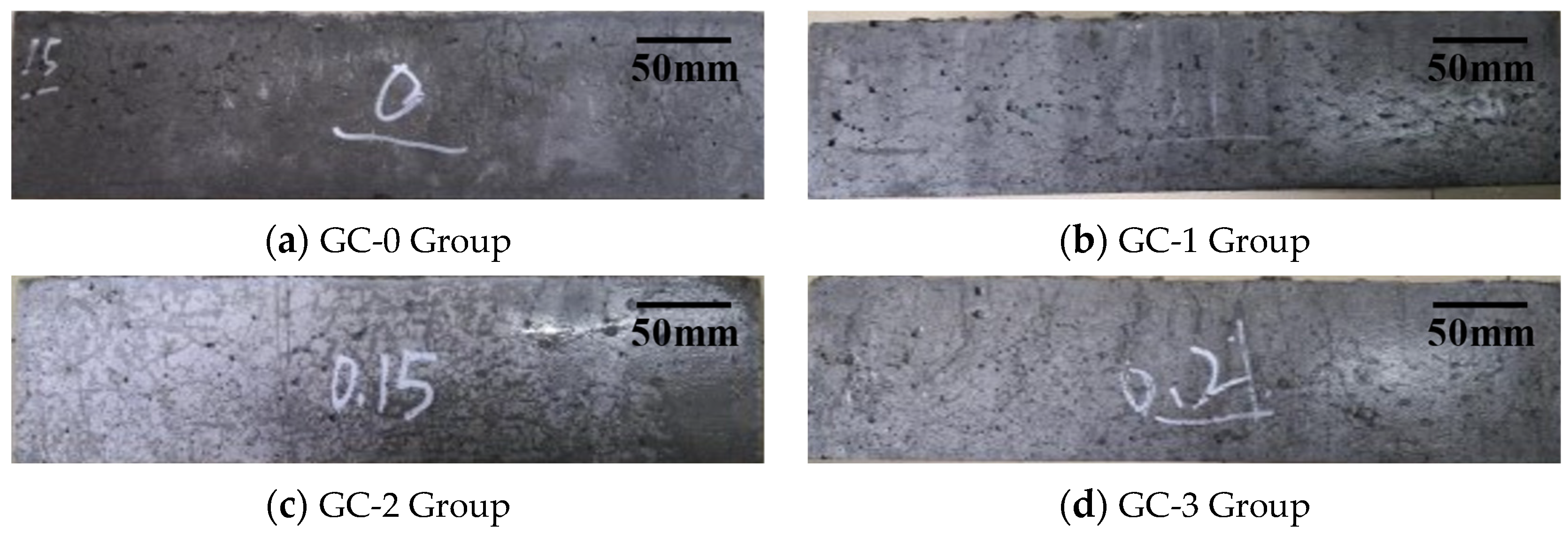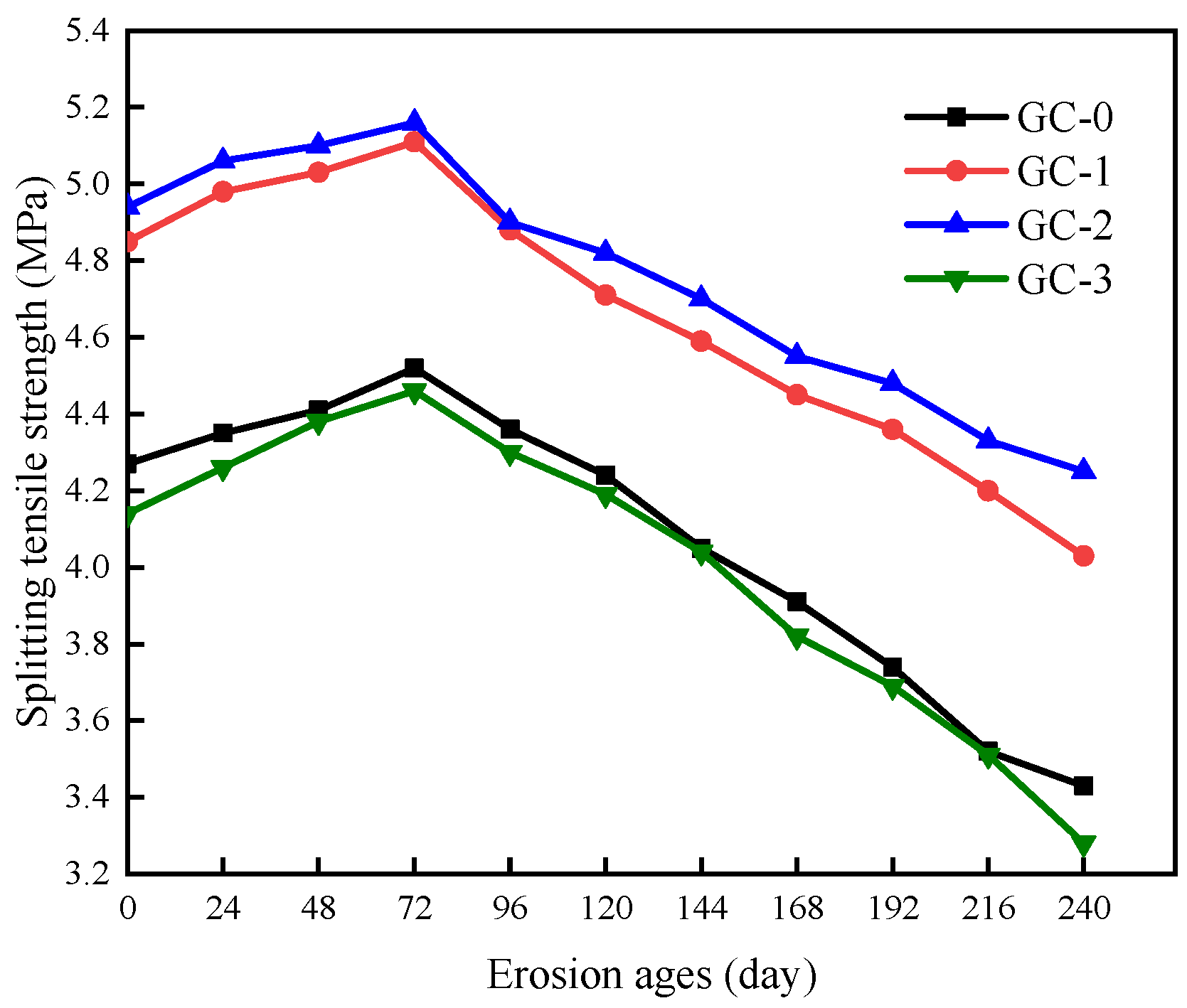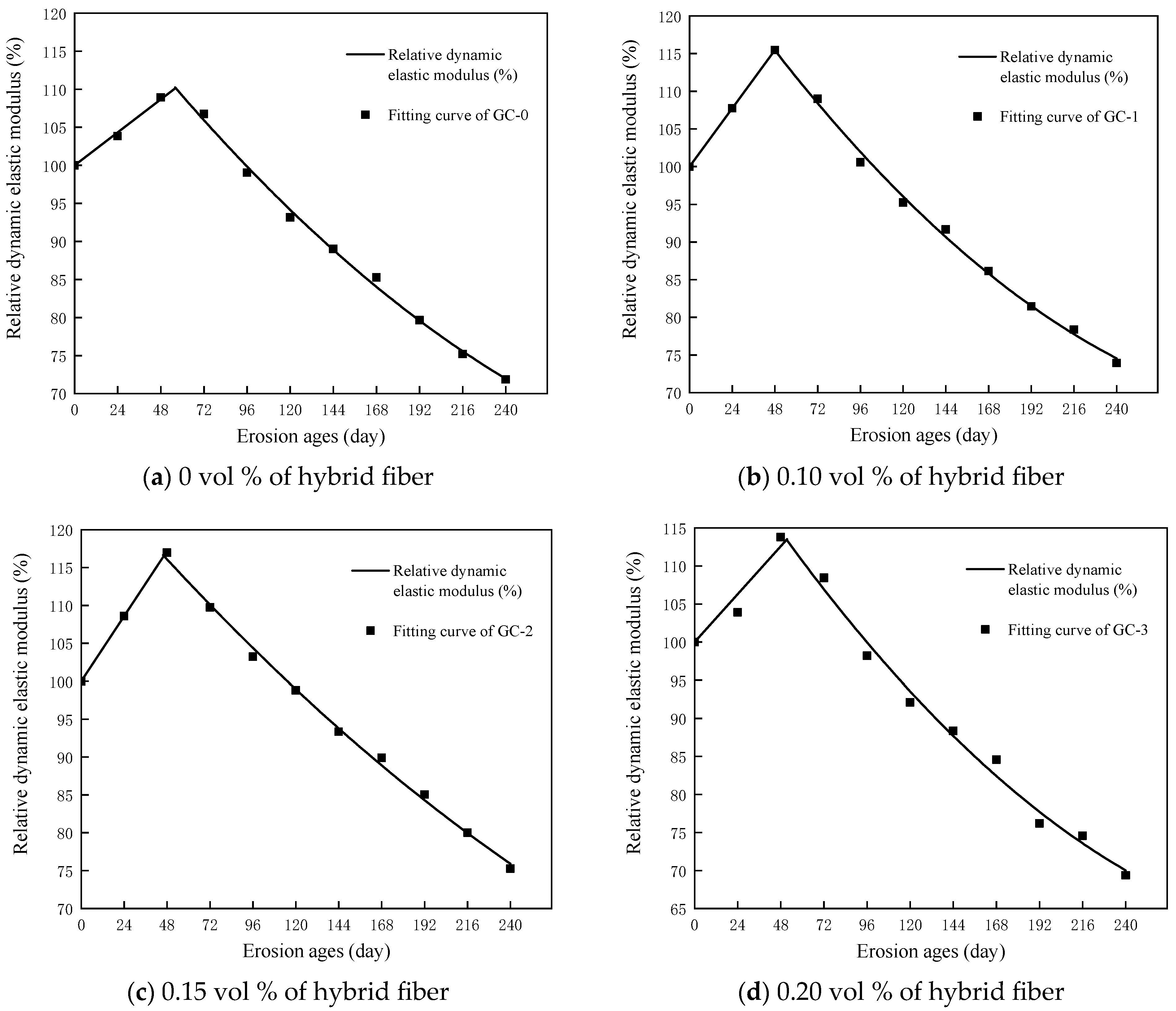Damage Evolution of Polypropylene–Basalt Hybrid Fiber Ceramsite Concrete under Chloride Erosion and Dry–Wet Cycle
Abstract
:1. Introduction
2. Materials and Methods
2.1. Raw Material
- (1)
- Cement: Huaxin brand P.O.42.5 ordinary Portland cement. The technical indicators are shown in Table 1.
- (2)
- Coarse aggregate: Yichang Guangda brand 900-grade high-strength gravel–shale ceramsite, performance parameters are shown in Table 2. The ceramsite is prewetted before preparing the concrete specimens.
- (3)
- Fine aggregate: ordinary river sand (medium sand), apparent density is 2.54 g/cm3, fineness modulus is 2.91.
- (4)
- (5)
- Water-reducing agent: HSC polycarboxylate high-performance water-reducing agent, the solid content of the water-reducing agent was 20%.
- (6)
- Water: tap water.
2.2. Mix Proportion of PBHFCC
2.3. The Test Scheme of Chloride Erosion and Dry–Wet Cycle
3. Results and Discussion
3.1. Appearance Change of Test Piece
3.2. Change Rule of Mass Loss
3.3. Change Rule of Relative Dynamic Elastic Modulus
3.4. Change and Analysis of Compressive Strength
3.5. Change and Analysis of Splitting Tensile Strength
3.6. Analysis of Damage Causes
3.7. Damage Model of PBHFCC under Chloride Erosion and Dry–Wet Cycle
- When t = 0, Erd1 = f (0) = 100;
- n the whole function interval t ∈ [0, t], f(t) ≥ 0;
- When t1 = t2 = t12, f(t1) = f(t2) = f(t12);
- When 0 ≤ t ≤ t12, f′(t) > 0; When t12 ≤ t2 ≤ tmax, f″(t2) < 0.
4. Conclusions
- (1)
- The durability of PBHFCC is affected by the number of erosion d and fiber content. The measured mechanical indexes increased first and then decreased with the increase in action time. An appropriate amount of fiber incorporation (0.10 vol %, 0.15 vol %) can effectively improve the durability of ceramsite concrete, while too-high fiber incorporation (0.20 vol %) will produce negative effects of hybrid fibers and aggravate erosion damage.
- (2)
- The apparent damage degree of each group of specimens increased gradually with the increase in action time. The durability damage of the specimens with hybrid fiber of 0.20 vol % was the most serious, and the damage degree was even slightly larger than that of the specimens without hybrid fiber. The damage degree of the specimen with hybrid fiber of 0.15 vol % was lighter.
- (3)
- The mass of PBHFCC in each group increased gradually during the first 72 d of erosion, and decreased rapidly after 72 d. The mass loss rate of the specimens with hybrid fiber of 0.15 vol % was the smallest in each stage of the test.
- (4)
- The relative dynamic elastic modulus increased gradually during the first 48 d of erosion and decreased gradually after 48 d. The relative dynamic elastic modulus of the specimen with hybrid fiber of 0.15 vol % was larger than that of the other three groups of specimens with the same erosion age.
- (5)
- The compressive strength of PBHFCC in each group increased gradually in the first 72 d and then decreased gradually. When the erosion age is 72 d, the compressive strength and splitting tensile strength of the hybrid fiber specimen with 0.15 vol % volume content reach the peak, which are 66.2 MPa and 5.16 MPa, respectively. Compared with the specimens without hybrid fibers, they were increased by 12.2% and 14.2%, respectively.
- (6)
- Taking the relative dynamic elastic modulus value as the damage variable, the linear function is used to represent the rising stage in the early stage, and the quadratic polynomial is used to represent the falling stage in the later stage. The damage evolution equation of PBHFCC considering the volume content of hybrid fiber under the action of chloride erosion and dry–wet cycle is well fitted, which can provide reference for the engineering design of PBHFCC in coastal areas.
Author Contributions
Funding
Institutional Review Board Statement
Data Availability Statement
Conflicts of Interest
References
- Wang, C.S.; Ren, X.Y.; Diao, Q.W.; Pan, X.Y.; Su, W.Q.; Chang, L.; Lin, B.; Yan, S. Sound absorption performance of a triple-hole structure in green ceramsite concrete for high-speed-railway sound barriers: Experiments and neural network modeling. Case Stud. Constr. Mater. 2023, 18, e01980. [Google Scholar] [CrossRef]
- Wu, T.; Yang, X.; Wei, H.; Liu, X. Mechanical properties and microstructure of lightweight aggregate concrete with and without fiber. Constr. Build. Mater. 2019, 199, 526–539. [Google Scholar] [CrossRef]
- Lin, H.J.; Zhu, B.J.; Yuan, J.; He, H.J.; Li, R.G.; Yu, J.; Shen, X.Y.; He, C.; Liu, J.D.; Xu, W. Study on the impact of HTPP fibers on the mechanical properties of ceramsite concrete. Case Stud. Constr. Mater. 2023, 19, e02471. [Google Scholar] [CrossRef]
- Gong, J.Q.; Zeng, W.; Zhang, W.J. Influence of shrinkage-reducing agent and polypropylene fiber on shrinkage of ceramsite concrete. Constr. Build. Mater. 2018, 159, 155–163. [Google Scholar] [CrossRef]
- Zeng, Y.S.; Li, X.M.; Tang, A.P.; Jia, S.M. Axial compressive behavior of basalt and polyacrylonitrile fibers reinforced lightweight aggregate concrete with industrial waste ceramsite-Lytag after freeze-thaw cycles. J. Build. 2023, 76, 107402. [Google Scholar] [CrossRef]
- Li, B.; Chi, Y.; Xu, L.H.; Shi, Y.C.; Li, C.N. Experimental investigation on the flexural behavior of steel-polypropylene hybrid fiber reinforced concrete. Constr. Build. Mater. 2018, 191, 80–94. [Google Scholar] [CrossRef]
- Smarzewski, P. Analysis of failure mechanics in hybrid fibre-reinforced high-performance concrete deep beams with and without openings. Materials 2019, 12, 101. [Google Scholar] [CrossRef]
- Alwesabi, E.A.H.; Bakar, B.H.A.; Alshaikh, I.M.H.; Akil, H.M. Experimental investigation on mechanical properties of plain and rubberised concretes with steel–polypropylene hybrid fibre. Constr. Build. Mater. 2020, 233, 117194. [Google Scholar] [CrossRef]
- Wu, H.Y.; Lin, X.S.; Zhou, A.N.; Zhang, Y.X. A temperature dependent constitutive model for hybrid fibre reinforced concrete. Constr. Build. Mater. 2023, 365, 130109. [Google Scholar] [CrossRef]
- Ralegaonkar, R.; Gavali, H.; Aswath, P.; Abolmaali, S. Application of chopped basalt fibers in reinforced mortar: A review. Constr. Build. Mater. 2018, 164, 589–602. [Google Scholar] [CrossRef]
- Li, Y.; Zhang, J.P.; He, Y.Z.; Huang, G.J.; Li, J.B.; Niu, Z.X.; Gao, B. A review on durability of basalt fiber reinforced concrete. Compos. Sci. Technol. 2022, 225, 109519. [Google Scholar] [CrossRef]
- Fan, S.J. Mechanical and durability performance of polyacrylonitrile fiber reinforced concrete. Mater. Res. 2015, 18, 1298–1303. [Google Scholar] [CrossRef]
- Banthia, N.; Gupta, R. Influence of polypropylene fiber geometry on plastic shrinkage cracking in concrete. Cem. Concr. Res. 2006, 36, 1263–1267. [Google Scholar] [CrossRef]
- Jiang, C.H.; Fan, K.; Wu, F.; Chen, D. Experimental study on the mechanical properties and microstructure of chopped basalt fibre reinforced concrete. Mater. Des. 2014, 58, 187–193. [Google Scholar] [CrossRef]
- Zeng, Y.S.; Zhou, X.Y.; Tang, A.P.; Sun, P. Mechanical properties of chopped basalt fiber-reinforced lightweight aggregate concrete and chopped polyacrylonitrile fiber reinforced lightweight aggregate concrete. Materials 2020, 13, 1715. [Google Scholar] [CrossRef] [PubMed]
- Yao, Y.; Wang, B.Q.; Yan, Z.G.; Huang, Z.H. Properties of hybrid basalt-polypropylene fiber reinforced mortar at different temperatures. Constr. Build. Mater. 2022, 346, 128433. [Google Scholar] [CrossRef]
- Fu, Q.; Xu, W.R.; Bu, M.X.; Guo, B.B.; Niu, D.T. Effect and action mechanism of fibers on mechanical behavior of hybrid basalt-polypropylene fiber-reinforced concrete. Structures 2021, 34, 3596–3610. [Google Scholar] [CrossRef]
- Yin, S.P.; Liu, Z.R.; Dong, P.J. Study on degradation of mechanical properties of BFRP bars wrapped with seawater sea sand concrete under chloride dry wet cycle. Constr. Build. Mater. 2022, 352, 129050. [Google Scholar] [CrossRef]
- Zhang, J.S.; Shu, Y.H.; Fang, A.N.; Qin, R.H.; Wu, Y.Q.; Zhang, J.J. Effect of dry-wet cycle on dynamic mechanical characteristics of EPS cement soil under different chloride salt environments. Case Stud. Constr. Mater. 2023, 18, e02151. [Google Scholar] [CrossRef]
- Wei, D.; Ji, Y.J. Chloride ion transport and service life prediction of aeolian sand concrete under dry–wet cycles. Sci. Eng. Compos. Mater. 2023, 30, 20220188. [Google Scholar] [CrossRef]
- Baltazar-Zamora, M.A.; Mendoza-Rangel, J.M.; Croche, R.; Gaona-Tiburcio, C.; Hernández, C.; López, L.; Olguín, F.; Almeraya-Calderón, F. Corrosion behavior of galvanized steel embedded in concrete exposed to soil type MH contaminated with chlorides. Front. Mater. 2019, 6, 257. [Google Scholar] [CrossRef]
- Subbiah, K.; Lee, H.S.; Park, T.; Annamalai, S. Studies on corrosion monitoring of reinforced concrete in a chloride environment using an embedded solid-state reference electrode. Constr. Build. Mater. 2023, 364, 129964. [Google Scholar] [CrossRef]
- Long, W.J.; Zhang, X.H.; Feng, G.L.; Xie, J.; Xing, F.; Dong, B.Q.; Zhang, J.R.; Khayat, K.H. Investigation on chloride binding capacity and stability of Friedel’s salt in graphene oxide reinforced cement paste. Cem. Concr. Compos. 2022, 132, 104603. [Google Scholar] [CrossRef]
- Chen, Q.; Ma, R.; Li, H.X.; Jiang, Z.W.; Zhu, H.H.; Yan, Z.G. Effect of chloride attack on the bonded concrete system repaired by UHPC. Constr. Build. Mater. 2021, 272, 121971. [Google Scholar] [CrossRef]
- Han, X.Q.; Zhan, S.L.; Xu, Q. Effect of dry-wet cycle on chloride ion penetration resistance of concrete. Acta Mater. Compos. Sin. 2020, 37, 198–204. (In Chinese) [Google Scholar] [CrossRef]
- Bao, J.W.; Zheng, R.; Wei, J.N.; Zhang, P.; Xue, S.B.; Liu, Z.L. Numerical and experimental investigation of coupled capillary suction and chloride penetration in unsaturated concrete under cyclic drying-wetting condition. J. Build. 2022, 51, 104273. [Google Scholar] [CrossRef]
- Huang, D.G.; Niu, D.T.; Su, L.; Fu, Q. Chloride diffusion behavior of coral aggregate concrete under drying-wetting cycles. Constr. Build. Mater. 2021, 270, 121485. [Google Scholar] [CrossRef]
- Chen, W.G.; Zhu, H.T.; He, Z.H.; Yang, L.; Zhao, L.P.; Wen, C.C. Experimental investigation on chloride-ion penetration resistance of slag containing fiber-reinforced concrete under drying-wetting cycles. Constr. Build. Mater. 2021, 274, 121829. [Google Scholar] [CrossRef]
- Algin, Z.; Ozen, M. The properties of chopped basalt fibre reinforced self-compacting concrete. Constr. Build. Mater. 2018, 186, 678–685. [Google Scholar] [CrossRef]
- Guo, Y.H.; Hu, X.Y.; Lv, J.F. Experimental study on the resistance of basalt fibre-reinforced concrete to chloride penetration. Constr. Build. Mater. 2019, 223, 142–155. [Google Scholar] [CrossRef]
- Qin, Y.; Men, B.; Liang, D.; Geng, K.Q.; Zhang, X.W.; Zhou, H.; Liu, R.F. Energy evolution of concrete with cold joint under the action of sulfate dry-wet cycles with loading. J. Build. 2023, 68, 106098. [Google Scholar] [CrossRef]
- GB/T 50081-2019; Standard for Test Methods of Concrete Physical and Mechanical Properties. The Standards Press of China: Beijing, China, 2019.
- Pansera, W.A.; Reichert, T.A.; Savaris, G.; Balestra, C.E.T. Nonlinear regression using Gaussian-Lorentzian functions to empirical modeling of convective-diffusive chloride transport in concrete. Constr. Build. Mater. 2022, 341, 127770. [Google Scholar] [CrossRef]
- Shi, Z.G.; Geiker, M.R.; Lothenbach, B.; Weerdt, K.D.; Garzón, S.F.; Enemark-Rasmussen, K.; Skibsted, J. Friedel’s salt profiles from thermogravimetric analysis and thermodynamic modelling of Portland cement-based mortars exposed to sodium chloride solution. Cem. Concr. Compos. 2017, 78, 73–83. [Google Scholar] [CrossRef]
- Zheng, Y.X.; Zhang, Y.; Zhuo, J.B.; Zhang, Y.M.; Wan, C. A review of the mechanical properties and durability of basalt fiber-reinforced concrete. Constr. Build. Mater. 2022, 359, 129360. [Google Scholar] [CrossRef]










| Performance Index | Stability | Initial Setting Time (Min) | Final Setting Time (Min) | Compressive Strength (MPa) | Flexural Strength (MPa) | ||
|---|---|---|---|---|---|---|---|
| 3 d | 28 d | 3 d | 28 d | ||||
| Measured value | Qualification | 110 | 350 | 22.5 | 47.3 | 4.8 | 7.6 |
| Materials Name | Grain Size (mm) | Packing Density (kg/m3) | Apparent Density (kg/m3) | Compressive Strength of Concrete Cylinder (MPa) | 2 h Water Absorption (%) | Fineness Modulus | Mud Content (%) |
|---|---|---|---|---|---|---|---|
| Ceramsite | 5~20 | 815 | 1505 | 6.2 | 2.46 | - | - |
| Sand | - | 1560 | 2650 | - | - | ≤2 | 2.65 |
| Fiber Name | Shape | Length (mm) | Diameter (um) | Density (g/cm3) | Elastic Modulus (GPa) | Extension at Break (%) | Tensile Strength (MPa) |
|---|---|---|---|---|---|---|---|
| Polypropylene fiber | Bunchy monofilament | 18 | 10~20 | 0.91 | ≥3.6 | 6~20 | ≥400 |
| Basalt fiber | Bunchy monofilament | 12 | 20~30 | 2.65 | 95~110 | 2.5~3.5 | 3800~4900 |
| Group No. | Volume Fraction of Hybrid Fiber (%) | Cement (kg/m3) | Ceramsite (kg/m3) | Sand (kg/m3) | Water (kg/m3) | PCS (kg/m3) | Average Compressive Strength of 28 d (MPa) | Average Splitting Tensile Strength of 28 d (MPa) |
|---|---|---|---|---|---|---|---|---|
| Reference group (GC-0) | 0.00 | 540 | 554 | 730 | 152 | 5.4 | 48.1 | 4.27 |
| Control group 1 (GC-1) | 0.10 | 540 | 554 | 730 | 152 | 5.4 | 49.6 | 4.85 |
| Control group 2 (GC-2) | 0.15 | 540 | 554 | 730 | 152 | 5.4 | 53.2 | 4.94 |
| Control group 3 (GC-3) | 0.20 | 540 | 554 | 730 | 152 | 5.4 | 47.2 | 4.14 |
| Group No. | Solution Type and Volume Concentration | Volume Fraction of Hybrid Fiber (%) | Number of Compression Strength Test Pieces (Piece) | Number of Splitting Tensile Strength Test Pieces (Piece) | Mass Loss Rate/Relative Dynamic Modulus of Elasticity Test Pieces (Piece) |
|---|---|---|---|---|---|
| GC-0 | NaCl 3.5% (in volume percent) | 0.00 | 3 × 11 | 3 × 11 | 3 |
| GC-1 | 0.10 | 3 × 11 | 3 × 11 | 3 | |
| GC-2 | 0.15 | 3 × 11 | 3 × 11 | 3 | |
| GC-3 | 0.20 | 3 × 11 | 3 × 11 | 3 |
| Group | Fit Parameter Value | Fitting Accuracy R2 | ||||
|---|---|---|---|---|---|---|
| A | C | D | E | t12 | ||
| GC-0 | 0.18108 | 3.5859 × 10−4 | −0.31427 | 126.71024 | 55.937 | 0.997 |
| GC-1 | 0.32292 | 4.69783 × 10−4 | −0.34817 | 131.04824 | 47.345 | 0.996 |
| GC-2 | 0.35792 | 2.40124 × 10−4 | −0.27834 | 128.89248 | 45.763 | 0.996 |
| GC-3 | 0.26267 | 4.93862 × 10−4 | −0.37393 | 131.30744 | 51.451 | 0.982 |
Disclaimer/Publisher’s Note: The statements, opinions and data contained in all publications are solely those of the individual author(s) and contributor(s) and not of MDPI and/or the editor(s). MDPI and/or the editor(s) disclaim responsibility for any injury to people or property resulting from any ideas, methods, instructions or products referred to in the content. |
© 2023 by the authors. Licensee MDPI, Basel, Switzerland. This article is an open access article distributed under the terms and conditions of the Creative Commons Attribution (CC BY) license (https://creativecommons.org/licenses/by/4.0/).
Share and Cite
Zhu, H.; Wen, S.; Li, X.; Li, Y.; Fu, Z. Damage Evolution of Polypropylene–Basalt Hybrid Fiber Ceramsite Concrete under Chloride Erosion and Dry–Wet Cycle. Polymers 2023, 15, 4179. https://doi.org/10.3390/polym15204179
Zhu H, Wen S, Li X, Li Y, Fu Z. Damage Evolution of Polypropylene–Basalt Hybrid Fiber Ceramsite Concrete under Chloride Erosion and Dry–Wet Cycle. Polymers. 2023; 15(20):4179. https://doi.org/10.3390/polym15204179
Chicago/Turabian StyleZhu, Hongbing, Siyu Wen, Xiu Li, Yahan Li, and Zhenghao Fu. 2023. "Damage Evolution of Polypropylene–Basalt Hybrid Fiber Ceramsite Concrete under Chloride Erosion and Dry–Wet Cycle" Polymers 15, no. 20: 4179. https://doi.org/10.3390/polym15204179
APA StyleZhu, H., Wen, S., Li, X., Li, Y., & Fu, Z. (2023). Damage Evolution of Polypropylene–Basalt Hybrid Fiber Ceramsite Concrete under Chloride Erosion and Dry–Wet Cycle. Polymers, 15(20), 4179. https://doi.org/10.3390/polym15204179









